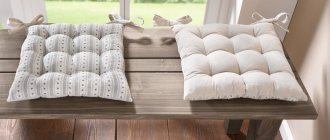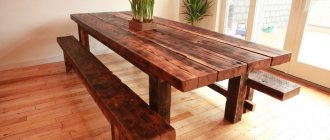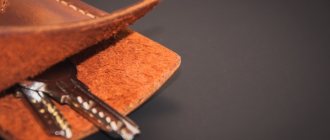Do-it-yourself restoration of a chair may be necessary when the furniture loses its newness and beauty. You will definitely have to update the chair if it is your favorite and is often used, since the upholstery of the chair loses its attractive appearance. In some cases, restoration of an old chair is necessary from an aesthetic point of view - when its design does not fit into the interior after renovation. Restoring a boring chair with fabric will help solve these problems.
Reupholstering an old chair will not take much time and effort from the worker. But what delight you will experience when you see what came out of the old chair! If you bought a cheap chair with wooden arms, it needs a makeover. Upholstering a chair with your own hands will give it newness and freshness.
Types of chairs
There are many different types of chairs, varying in level of comfort, cost, and methods of placement in space. The design is an “improved chair”, which has a soft back and seat covered with textiles, leather, faux leather, fur, and in some cases, armrests, a footrest, and a rocking mechanism.
The main classification looks like this:
- by purpose - for relaxation (interior), for work (office);
- according to design features - with a rigid frame, without a frame;
- at the place of installation - in the living room, in the garden or on the veranda, office (computer), gaming (game) rooms.
The design of the item itself is also different, there are:
- ordinary - installed on four legs, have a soft back, armrests, coffee stands, poufs, and other details that provide maximum comfort;
- chair-beds - designed for cramped rooms, significantly saving space. It is not recommended to constantly sleep on such furniture, but it is possible to place an unexpected guest who is staying overnight on it, and also to use it in a summer cottage;
- rocking chairs - made classic (on ski runners), with a pendulum mechanism (have a fixed base), spring (rattan papsan rocking chairs), as well as “Viennese chairs” (runners are connected in a closed circle);
- advertisers are especially comfortable, expensive models that can be fully reclined and have a footrest. Transformable manually or electrically. A ventilation system, mini-bar, vibration massage, etc. are sometimes built in here;
- hanging - it can be a hammock, an “egg”, a ball, a “cocoon”. Hanging is done on the ceiling, wall, stand, beam.
Frame models are made of natural wood, metal, plywood, chipboard, and plastic. Usually several materials are used at the same time. Frameless options are pillow bags filled with foam balls and synthetic fluff. There are also convertible, lightweight inflatable items.
How to restore a chair back
Here you will need a special stapler for furniture and staples for it (6 mm - 2 packs and 10 mm - 1 pack).
Chair reupholstery diagram.
If the tie strips are loose, they need to be tightened. To do this, you need to remove the tape on one side, pull it up and secure it with a stapler. It happens that the tapes are no longer usable, in which case they need to be completely replaced with new ones.
For old chairs, it is typical to pass longitudinal strips between transverse ones in a checkerboard pattern. If the back is uneven (curved), it is better to run the tape over the transverse tie. In this case, the load is distributed more efficiently, and the chair will no longer sit down.
All excess tape must be cut off, otherwise lumps may form after re-tightening.
Features of do-it-yourself banners
Anyone who decides to remake an old chair into a more modern one is completely free to choose materials and the style of the future design. Before starting work, you should decide in which room the product will be placed and who will use it. For the nursery, “cheerful” colors are selected, but non-staining, natural fabrics. The kitchen uses materials that do not absorb liquids and odors. It is important that the updated item fits optimally into the existing interior. Depending on the design of the upholstered furniture and the accuracy of the craftsman, its repair will take from a couple of hours to several days.
Renewing ancient, rare items of historical value should be done very carefully; sometimes it is even worth entrusting such a task to specialists.
Preparatory work
Reupholstery is preceded by disassembling the chair into its component parts, so the question arises: how to change the upholstery on the chairs so as not to get confused later during the reassembly process? Before starting work, it is highly advisable to photograph the chair from all angles so that you can see how the parts are connected.
If 2 chairs are being reupholstered, you can do without photographs, you just need to not disassemble both at once, but focus on one as a sample. Sometimes the upholstery sag due to wear and tear on the filling, but the material is in good condition. In this case, the filler is changed, and the old upholstery is reupholstered. If it has faded or worn out, you need to choose a new upholstery material and decide how much of it will be needed for all the details. When choosing upholstery fabric you should consider:
- your budget - the price range of materials is very wide;
- interior features - updated furniture should be in harmony with the rest of the decor;
- operating mode of the chair - in some cases you need the most wear-resistant, non-marking material, in other situations you can choose a more delicate one.
By measuring the dimensions of the parts that need to be reupholstered, you can approximately calculate the amount of fabric. A more accurate result will be obtained if measurements are taken after dismantling the old upholstery - you can rip it apart at the seams and add up the dimensions of all the fabric parts.
Step-by-step dismantling is performed in the following sequence:
- Back wall.
- Legs and base (bottom).
- Exterior wood parts (if available).
- Upholstery.
- Foam rubber.
To decide on the dismantling method, you need to understand how the parts are connected to each other. When dismantling parts made of plywood (bottom, rear wall), screws are unscrewed, nails are pulled out, and staples are bent. If the nuts are stuck, the joints are treated with anti-corrosion liquid. Armrests and other external wooden parts are removed using a screwdriver and hammer. To remove the fabric, bend the staples that secure it; if the upholstery was made with ties, it is also necessary to cut or untie the ropes and remove furniture buttons. The foam rubber is inspected and a decision is made whether it needs to be changed completely or whether it is enough to add a new layer.
When removing the upholstery, you need to write down the dismantling sequence so that you can then attach the new upholstery in the reverse order. You can directly apply numbers to the parts of the old upholstery and write comments regarding the method of fastening each one.
It is recommended to treat all metal parts that will be reused with an anti-corrosion compound, and wooden frame parts with an antiseptic to remove unpleasant odors. The wood also needs to be sanded, any glue drips and foam residues removed.
Advantages and disadvantages
Hand-made reupholstery of home and office furniture has many advantages:
- significant budget savings - it’s easier to buy a couple of meters of textiles and a piece of foam rubber than a whole new chair;
- creative process - independently remaking even the simplest, nondescript chair will help you feel like a real master;
- the possibility of updating the interior - a freshly redesigned chair will be designed exactly as its owner intended;
- A quality restored product will last for many years.
There are also several negative points:
- the product will be very different from the store one - this matters if you want to create a specific model, but the skills are not yet enough;
- the labor-intensive process - if the chair is badly damaged, not only the fabric is replaced, but also the “filling” - foam rubber, springs, while completely disassembling it;
- For work you will need some tools that are not available in every home;
- You will need to organize a workspace, which will then have to be thoroughly cleaned, since the restoration process is quite dusty.
What material is best for repairing and reupholstering office chairs?
The new upholstery of the chair must be durable and dense, since office furniture is subject to serious operating loads. As a rule, expensive office chairs are sent for reupholstery, which, despite the worn upholstery, have a strong frame. The cost of reupholstering an office chair in this case will be significantly lower than the cost of a new chair. What materials are suitable for reupholstery?
- Genuine Leather. The classic version: the material looks expensive, is pleasant to the touch, and has high strength. The only negative is that you will have to take care of the leather and protect the chair from direct damage
- Faux leather or eco leather. The material looks no worse than natural, but does not have the same softness. The main advantage of eco-leather is its different colors, shades and textures, among which there is an option for any interior.
- Upholstery fabric. In this case, you should give preference to dense textiles like microfiber: thin fabric will not withstand constant friction
- Anti-vandal upholstery. The best material from the point of view of strength, since it is not afraid of cuts, strong dyes, and high operating loads. Anti-vandal upholstery does not require special care and is easy to wash and clean.
So, the classic option is upholstering an office chair with leather. He is also the most expensive. Faux leather or fabric is a democratic, but less spectacular upholstery. The most modern and practical material for an office chair is vandal-proof upholstery, which cannot be stained or cut.
Fabric selection
The modern variety of fabrics and non-woven materials will allow you to choose the best option for decorating almost any design. Experts divide all textiles into nine types - from zero to eight, where the zero group includes the thinnest, cheapest, and quickly wiped, and the eighth group includes the most expensive, durable, wear-resistant. They are made from natural, artificial, and mixed fibers, differing in the way the fabric is woven. Non-woven materials are also used for upholstery.
The ideal upholstery material should be:
- wear-resistant;
- durable;
- durable;
- colorfast;
- hydrophobic;
- smooth;
- soft.
The most popular options:
- tapestry;
- flock;
- chenille;
- jacquard;
- scotchguard;
- thermojacquard;
- velours;
- matting;
- boucle;
- leatherette;
- microfiber;
- leather.
Some natural fabrics exhibit significant (more than 10%) shrinkage, which must always be taken into account.
Seat preparation
Stages of sewing the side part of a chair cover.
Related article: Wall panels for the corridor - stylish interiors for any budget!
The fabric from the seat is removed in the same way as from the back. All old nails or screws are removed.
The rubber bands also need to be tightened with pliers and secured with a stapler. It is better to shoot the staples in different directions, this way you will avoid tearing the tape.
As in the previous case, the old sheathing is not thrown away, but is used as a substrate. If the foam on the back is suitable for use, then you do not need to replace it; you can put it on the seat. Lay the foam so that all edges protrude slightly and one does not reach the edge. The foam rubber is glued, the excess is removed with a knife.
If the foam rubber consists of several parts, then the joints should be glued, otherwise the gasket may separate along the seam.
The same method is used to fix a new soft lining if the old foam is no longer suitable for use.
How to take measurements correctly and calculate the amount of fabric
The easiest way to find out how much textile and foam rubber you will need for upholstery is to disassemble the item itself, remove the covering from it, and trace it on a new piece of fabric. The disadvantage of this method is that during use the fabric could stretch greatly. They measure more accurately this way: take measurements directly from the chair itself, using a tape measure. Here the width, length, height of the soft part are taken into account, and 10-15% is added to the results obtained for allowances. For a standard “home” chair you will need a piece of fabric measuring approximately 350 by 140 cm, for an office chair – 170 by 140 cm.
If you plan to decorate the armchair with a valance or voluminous pleated elements, 40-70% more material will be required. When a large pattern is applied to the textile, which will have to be combined here and there, it is also taken with a reserve.
Selecting and preparing fabric for upholstery
Of course, when choosing material for upholstering a chair, many rely solely on their own taste. When considering fabric or leather, from the point of view of upholstery material, they evaluate the texture, color scheme, and the presence or absence of a print. But at the same time, many people forget that they will have to upholster furniture with this fabric. But you will have to sit on the chair and subject it to mechanical stress and additional friction.
If you have pets, such as a dog or cat, flock is perfect. This material is resistant to scratches and holes from sharp claws.
It is for this reason that the upholstery must meet the following conditions:
- You can only cover it with thick material. Thin fabric will quickly break through and the whole manipulation will have to be redone.
- Strength is another important parameter. There are materials that have fibers that cannot be broken. Therefore, it is worth choosing fabric or leather materials specially created for furniture work.
- Another important factor is practicality. Remember that furniture sometimes requires cleaning. Therefore, it is better if the fabric can be easily cleaned with a vacuum cleaner, brush or damp cloth.
Necessary tools and materials for restoration work
To successfully repair a chair you will need:
- furniture stapler with a set of staples - for fastening fabric;
- foam rubber, batting - as padding;
- pry bar - for removing old staples;
- screwdriver, pliers - for disassembling the product;
- hammer, adjustable wrench - to assemble the structure;
- sewing machine;
- pins;
- fabric chalk;
- sharp scissors;
- stain, varnish;
- sandpaper or sander - to clean wooden parts from old varnish.
Disassembly
The next stage after preparation is dismantling the furniture. It requires the following tools:
- pliers;
- keys;
- screwdrivers (Phillips and regular);
- pliers.
Disassembly consists of several stages:
- Remove the back cover and the plywood that is located at the bottom of the chair. If the plywood is in good condition, you need to remove it as carefully as possible so as not to damage it.
- Remove the foam pad that is located at the bottom of the chair.
- Remove the upholstery and pull out the soft layer from the backrest. A flathead screwdriver and pliers will help you do this. With their help you need to pry and pull out the staples.
- Gradually remove all fasteners (brackets).
- Remove upholstery and foam from all parts of the chair. It is worth remembering that old foam rubber can crumble. Therefore, it is necessary to cover the floor with paper or film in advance.
In the process of restoration
After the furniture has been disassembled, it is necessary to inspect its frame. If necessary, strengthen loose parts and renew the paint.
Step-by-step instructions for reupholstering a chair with your own hands
Reupholstery of upholstered furniture begins with complete disassembly of the product and inspection of existing damage. Afterwards, the soft filler and fabric are measured, cut, and secured. The structure is assembled and decorated at your own discretion. Before starting work, it is recommended to read the instructions on how to disassemble and upholster the chair step by step.
Disassembly
Most old chairs are made of wood or from materials such as chipboard, and the fastenings are made on a tongue-and-groove basis, using steel corners, self-tapping screws, and wood glue. To disassemble the product, place it on its back, unscrew the legs and armrests. Next, disassemble the bottom, removing staples and other fasteners from it. Then the upholstery is removed as carefully as possible, which needs to be detached without damaging it, since it will be needed to cut out a new cover.
When disassembling, it is important to remember where everything was attached, otherwise there will be difficulties with assembly.
Assessment, damage correction
When the product is completely disassembled, all parts are disconnected, the fabric is removed, a thorough examination is carried out for cracks, chips, and joint defects. If such are found, they are dealt with first - broken parts are replaced with similar, homemade ones, loose connections are replaced. You also need to evaluate the condition of the padding - when the soft surface has serious unevenness, the material is torn or crumbles, it is removed, and a new one is nailed into the vacant space with staples. To make the edges look aesthetically pleasing, the corners of the foam rubber are cut off and something like a chamfer is made along the edge.
Cutting and attaching new fabric
The chair must be covered with properly cut material. Its quantity is calculated based on the perimeter of the back, seat, height of the filler, a few centimeters of hem on the back side of the structure. After measuring the product, a piece of fabric of the required size is selected. The standard fabric width is 140-150 cm, the length depends on the size of the chair, the height of the backrest, and the number of parts. If the structure is folding, a small allowance for unfolding is also necessary.
The standard set of elements is something like this:
- the front part of the backrest and seat are sometimes made in the form of a single piece;
- back surface of the back;
- armrests – internal, external parts;
- a narrow strip along the bottom;
- Some designs require the presence of side parts for armrests and backrest.
All fabric parts are pinned together, tried on a chair, and if necessary, the patterns are slightly adjusted. Next, the elements are sewn down on a sewing machine, the finished cover is put on the chair, pulled tightly, and secured with staples in inconspicuous places. If the work is done manually, use a “sail” or “denim” seam. If you have an overlocker, all seams are sewn over it - this will make the upholstery denser and prevent the joints from unraveling.
If fabric with pile is used, its direction on different parts of the structure must be monitored, since the multidirectionality is too visible in the light.
Assembly, decor of the updated product
The most difficult thing to assemble is a folding chair, since you will have to carefully fasten the moving mechanisms without losing the bolts or putting the part upside down. If the mechanism creaks or jams, lubricate it with machine oil. At the same stage, wooden parts are processed - they are sanded, tinted with stain, and varnished. The legs and wooden armrests are screwed in at the very end.
Pillows are most often used as decoration. They are sewn from the same fabric as the upholstery, made contrasting, decorated with embroidery and appliqué. If a product has many wooden parts, they are hand-painted and patinated.
How to avoid mistakes
It is almost impossible to make mistakes in such an easy process. But if this is your first time doing this, pay attention to:
- Correctness of measurements.
- Don't forget about the allowance. If there is more fabric left, it can be cut off; if there is less of it, it will not be able to cover the entire area of the part.
- Take care to store all removed parts.
- Choose the right upholstery option that will stretch and be comfortable to work with.
- If you are worried and find it difficult to remember the sequence, you can use your smartphone. Take a photo of each step you take and at the end, you will carry out the assembly based on the reverse.
To avoid mistakes, you should adhere to certain rules.
The whole thing depends on your attentiveness and accuracy. And it is quite possible that, being a beginner in such a matter, you will be able to do everything the first time without errors.
The nuances of restoring chairs with a spring mechanism
When upholstered furniture contains spring blocks, they can also “fail” over time. The springs are straightened with pliers, and the felt lining under them is changed if the latter is severely damaged. Sometimes it is necessary to tie and shrink the block itself - for this they use jute twine and belts. If there is a lot of damage, the spring structure is removed completely, replaced with several layers of foam rubber or a more modern design, where each spring is in a separate durable case.
How to remove upholstery from the back of a chair
First, the upholstery is removed from the back. As a rule, it is simply glued and can be easily removed. You need to pry up the edge of the fabric with a screwdriver and tear it off or trim the trim with a knife.
- Don't rush to throw away the fabric; you may need it. The back is covered with it before the foam is laid. The softening pad will lie on the prepared base and will not tear along the strips.
- To secure the removed upholstery, you need to smooth out the fabric on the back. Upholstery from the left corner using a stapler. The fastening pitch is short, approximately 1 cm.
- You need to stretch the fabric skillfully so that it does not form folds diagonally and does not hang. The formation of small folds, of course, is not prohibited; they can be leveled by tensioning the sheathing from the parallel side.
- Having secured the fabric on one side, move to the opposite. Then the upholstery is secured with a stapler along the remaining sides, while the fabric must be constantly tightened.
The corners are folded into an envelope, all excess is cut off. The folds must be fastened in such a way that one staple grabs both sides of the fold at once.
Office computer chair reupholstery
In order to save the budget spent on updating the office environment, computer chairs are also restored by hand. If the frame is completely intact, only re-upholstery is required, which gives the structure an aesthetic appearance. Since the chair is used many hours a day, the most wear-resistant, durable fabrics, as well as genuine leather, are selected for upholstery. Leatherette and thin textiles will become unusable in a matter of months.
Measurements are taken separately from the back and seat, taking into account their thickness, allowances for turning and seams. If the filler is “leaky”, additional foam rubber is purchased. The product is disassembled using a screwdriver, the seat, back, and armrests are disconnected. In the process, it is important not to lose all the screws - it is better to put them in a box. Next, the upholstery is separated, and new foam rubber is attached in its place with construction staples. Afterwards the fabric is stretched - it is important that folds do not form on the surface. Now the chair is going back together.
Disassembling the chair
First of all, to start reupholstering an old chair with your own hands, you need to unscrew the legs using a screwdriver or wrenches, then the armrests, if any on this model. Then they move to the bottom of the product. Remove the fasteners of the old upholstery and the upholstery itself around the perimeter of the chair.
If necessary, unscrew the back and also remove the old fabric. It is very important to remember or mark the order of disassembly. After all, then you will have to assemble everything in the reverse order.
How to sew chair covers
To prevent the furniture upholstery from being wiped out or damaged by children and pets, a cover is sewn on it. It is advisable that within the same room all objects are decorated with the same material - this way the decor will not be disjointed. Fabrics used are cotton, velor, as well as flock, chenille, and microfiber.
Design solutions for capes are very different - they are country and loft, Provence and shabby chic, high-tech and baroque. Usually the cover completely covers the product, reaching the floor. Parts List:
- back – front, back, side;
- seat – upper, front part;
- armrests – two side, two end parts.
The patterns are traced on the fabric with allowances for a loose fit and seams, one or two cm. The parts are sewn on the wrong side, the cover is turned inside out and tried on. If the model provides for it, a valance skirt is sewn to the bottom. The latter is made multi-layered, lace, contrasting (the color matches the sides of the back and armrests), it will require a lot of fabric.
The cover is usually made from one or two shades of textile; it is not recommended to use more than three colors.
How to reupholster a chair: stages of work
To complete the work, you need to have the following tools and materials:
- foam;
- fabric for upholstery;
- screws, self-tapping screws, nails;
- nail puller;
- pliers;
- screwdriver or screwdrivers.
Sequence of work:
Diagram of the chair structure.
- The first step is to dismantle the bottom and the wall behind the chair. To do this, you only need to pull out small nails or unscrew the screws. Most likely, the plywood can be used in the future, so try not to damage it.
- Then the soft foam pad is removed. The legs, which are secured with nuts to the back, are unscrewed. If unscrewing is not possible, then anti-corrosion fluid must be applied to the threads.
- The casing is removed and the foam rubber is removed. In order to remove the staples, you need to pry them off with a screwdriver and remove them with pliers.
- After removing all fasteners, remove the old foam rubber. It can crumble, so it is better to lay plastic film on the floor in advance.
It is better to work with gloves; if rust gets into the wound, you can get blood poisoning. The frame is restored separately. You need to remove all the varnish with sandpaper, fix the loose elements and paint it again.
Related article: Wallpaper for a dark bedroom
Reupholstering a chair: instructions
It is better to select new upholstery from special materials: gabardine, tapestry, velor, etc. It is better not to take material with geometric shapes or stripes; it is much more difficult to lay it evenly without distortions. In addition, to combine the material, you will need additional fabric. Faux fur looks great, but its service life is limited (it wears out quickly).
Fixing the upholstery begins from the side of the backrest. The fabric is not attached to the end; 10 cm is left along the lower and upper edges. The adjustment step for the staples is 10-15 cm. The covering is attached from the middle.
In order for the upholstery to adhere well to the frame, it is secured with staples.
Having secured one side of the fabric, you need to stand on the other side of the structure and pull the fabric towards you, checking the evenness; the ribs of the gasket should not be visible.
The excess is trimmed off and the upholstery is attached to the underside of the back of the chair. Before padding the top, you need to trim the soft foam at an angle of approximately 70°. Otherwise, a foam bump may form behind the chair. Having attached the fabric, holes are cut at the fastening points. The seat is trimmed in the same way.
Related article: Inspire curtains for modern interior design
Having finished the work, you can begin to draw up the corners. The edge of the fabric is folded on one side, and the remaining free one is folded in half, forming a triangle. Using a stapler, one edge of the half is attached, after which the second part is superimposed on the first. The folds can be straightened using a screwdriver. The resulting edge is also targeted with a stapler. The excess is cut off and holes are made for the bolts.
Assembling an upholstered chair
Once the fabric is completely secured, you can begin assembling the chair. The seat is connected to the backrest. Then the legs are screwed on. Next you need to install the plywood pieces on the back and bottom of the chair.
The plywood must be sheathed in advance. It is better to take the same fabric as for the main work. A sheet of plywood is laid on the cut fabric, the edges are folded, and the upholstery is secured with a stapler. If the plywood is not very thick, then it is better to perform the work in a vertical position. Here you will need small brackets that will not pierce through the skin. The finished wall is secured in place using nails or self-tapping screws.
The sheet is not attached from below along the entire perimeter, but only at the ends. The stapler does not always pierce the plywood; you can use a hammer to finish it. Before fixing the bottom part, a foam rubber cushion is laid, then the bottom is secured with screws.
You can be happy about the work done. Firstly, the work process is quite simple and does not take much time, and secondly, the cost of the materials used cannot be compared with purchasing a new chair.











